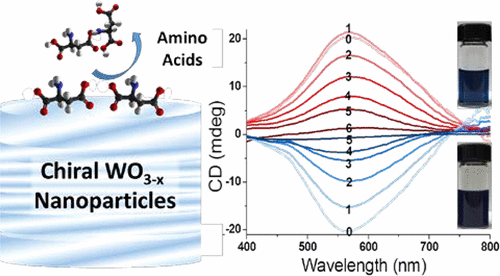当前位置:
X-MOL 学术
›
J. Am. Chem. Soc.
›
论文详情
Our official English website, www.x-mol.net, welcomes your
feedback! (Note: you will need to create a separate account there.)
Chiral Ceramic Nanoparticles and Peptide Catalysis
Journal of the American Chemical Society ( IF 14.4 ) Pub Date : 2017-09-20 00:00:00 , DOI: 10.1021/jacs.7b01445 Shuang Jiang 1, 2, 3 , Mahshid Chekini , Zhi-Bei Qu , Yichun Wang , Aydan Yeltik 4 , Yuangang Liu 5 , Alex Kotlyar , Tianyong Zhang 1, 2, 3 , Bin Li 1, 2, 3 , Hilmi Volkan Demir 4, 6 , Nicholas A. Kotov
Journal of the American Chemical Society ( IF 14.4 ) Pub Date : 2017-09-20 00:00:00 , DOI: 10.1021/jacs.7b01445 Shuang Jiang 1, 2, 3 , Mahshid Chekini , Zhi-Bei Qu , Yichun Wang , Aydan Yeltik 4 , Yuangang Liu 5 , Alex Kotlyar , Tianyong Zhang 1, 2, 3 , Bin Li 1, 2, 3 , Hilmi Volkan Demir 4, 6 , Nicholas A. Kotov
Affiliation

|
The chirality of nanoparticles (NPs) and their assemblies has been investigated predominantly for noble metals and II–VI semiconductors. However, ceramic NPs represent the majority of nanoscale materials in nature. The robustness and other innate properties of ceramics offer technological opportunities in catalysis, biomedical sciences, and optics. Here we report the preparation of chiral ceramic NPs, as represented by tungsten oxide hydrate, WO3–x·H2O, dispersed in ethanol. The chirality of the metal oxide core, with an average size of ca. 1.6 nm, is imparted by proline (Pro) and aspartic acid (Asp) ligands via bio-to-nano chirality transfer. The amino acids are attached to the NP surface through C–O–W linkages formed from dissociated carboxyl groups and through amino groups weakly coordinated to the NP surface. Surprisingly, the dominant circular dichroism bands for NPs coated by Pro and Asp are different despite the similarity in the geometry of the NPs; they are positioned at 400–700 nm and 500–1100 nm for Pro- and Asp-modified NPs, respectively. The differences in the spectral positions of the main chiroptical band for the two types of NPs are associated with the molecular binding of the two amino acids to the NP surface; Asp has one additional C–O–W linkage compared to Pro, resulting in stronger distortion of the inorganic crystal lattice and greater intensity of CD bands associated with the chirality of the inorganic core. The chirality of WO3–x·H2O atomic structure is confirmed by atomistic molecular dynamics simulations. The proximity of the amino acids to the mineral surface is associated with the catalytic abilities of WO3–x·H2O NPs. We found that NPs facilitate formation of peptide bonds, leading to Asp-Asp and Asp-Pro dipeptides. The chiroptical activity, chemical reactivity, and biocompatibility of tungsten oxide create a unique combination of properties relevant to chiral optics, chemical technologies, and biomedicine.
中文翻译:

手性陶瓷纳米粒子和肽催化
主要针对贵金属和II-VI半导体研究了纳米颗粒(NPs)及其组装体的手性。但是,陶瓷纳米颗粒代表了自然界中大多数纳米级材料。陶瓷的坚固性和其他固有特性为催化,生物医学和光学提供了技术机遇。在这里,我们报告以水合氧化钨WO 3– x ·H 2为代表的手性陶瓷纳米颗粒的制备O,分散在乙醇中。金属氧化物核的手性,平均大小约为。脯氨酸(Pro)和天冬氨酸(Asp)配体通过生物-纳米手性传递赋予1.6 nm的光。氨基酸通过由离解的羧基形成的C–W–W键和弱结合到NP表面的氨基连接到NP表面。出乎意料的是,尽管NP的几何结构相似,但Pro和Asp涂覆的NP的主要圆二色性谱带却不同。对于Pro和Asp修饰的NP,它们分别位于400-700 nm和500-1100 nm。两种类型NP的主要手性谱带光谱位置的差异与两种氨基酸与NP表面的分子结合有关。与Pro相比,Asp具有一个额外的C–O–W链接,导致无机晶格的更强扭曲以及与无机核的手性相关的更大的CD谱带强度。WO的手性通过原子分子动力学模拟证实了3– x ·H 2 O的原子结构。氨基酸与矿物表面的接近程度与WO 3– x ·H 2 O NPs的催化能力有关。我们发现NPs促进肽键的形成,导致Asp-Asp和Asp-Pro二肽。氧化钨的手性活性,化学反应性和生物相容性创造了与手性光学,化学技术和生物医学有关的特性的独特组合。
更新日期:2017-09-20
中文翻译:

手性陶瓷纳米粒子和肽催化
主要针对贵金属和II-VI半导体研究了纳米颗粒(NPs)及其组装体的手性。但是,陶瓷纳米颗粒代表了自然界中大多数纳米级材料。陶瓷的坚固性和其他固有特性为催化,生物医学和光学提供了技术机遇。在这里,我们报告以水合氧化钨WO 3– x ·H 2为代表的手性陶瓷纳米颗粒的制备O,分散在乙醇中。金属氧化物核的手性,平均大小约为。脯氨酸(Pro)和天冬氨酸(Asp)配体通过生物-纳米手性传递赋予1.6 nm的光。氨基酸通过由离解的羧基形成的C–W–W键和弱结合到NP表面的氨基连接到NP表面。出乎意料的是,尽管NP的几何结构相似,但Pro和Asp涂覆的NP的主要圆二色性谱带却不同。对于Pro和Asp修饰的NP,它们分别位于400-700 nm和500-1100 nm。两种类型NP的主要手性谱带光谱位置的差异与两种氨基酸与NP表面的分子结合有关。与Pro相比,Asp具有一个额外的C–O–W链接,导致无机晶格的更强扭曲以及与无机核的手性相关的更大的CD谱带强度。WO的手性通过原子分子动力学模拟证实了3– x ·H 2 O的原子结构。氨基酸与矿物表面的接近程度与WO 3– x ·H 2 O NPs的催化能力有关。我们发现NPs促进肽键的形成,导致Asp-Asp和Asp-Pro二肽。氧化钨的手性活性,化学反应性和生物相容性创造了与手性光学,化学技术和生物医学有关的特性的独特组合。










































 京公网安备 11010802027423号
京公网安备 11010802027423号